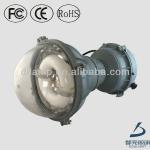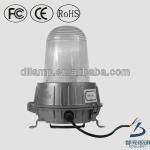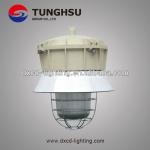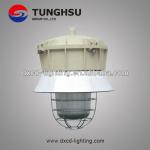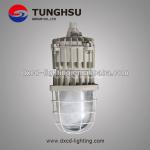Canopy Series AC1503 - AC1503
| Item Type: Explosion-proof Lights | Light Source: Induction Lamps | Input Voltage(V): 120-277 | Lamp Power(W): 100 |
| Lamp Luminous Flux(lm): 8,200 | Lamp Luminous Efficiency(lm/w): 82 | CRI (Ra>): 80 | Color Temperature(CCT): Pure White |
| Working Temperature(℃): -25 - 60 | Working Lifetime(Hour): 100000 | IP Rating: IP43 | Certification: CE,FCC |
| Lamp Body Material: Aluminum | Base Type: Custom | Place of Origin: Shanghai China (Mainland) | Brand Name: AGP |
| Model Number: AC1503 |

• Protection Class: IP54
• Size: 11.33” D x 11.33” H OR 30.88” D x 11.22” H
• Durable And Heat Resistant Acrylic
• Available Wattage: 40W, 80W
• 5 Year Warranty
• UL, CE, and FCC Listed Induction Fixture
FEATURES
• Quality Anodized Aluminum Reflector Evenly Distributes Light
• Heat Resistant Polycarbonate Lens
• Flicker And Glare Free Light Source
• Savings Of 60% Over HID Light Sources
• Ideal For Gas Stations, Walkways, And Public Facilities
Model Wattage Voltag(v) Lumens Visible Flux(Plm) Light Output CRI OperatingTemperature
AC1503-E2-080-5 80 120-277 6,560 9,600-11,100 5000K >80 -13~140º F
AC1503-E2-100-5 100 120-277 8,200 12,000-14,0 00 5000K >80 -13~140º F
Induction Lighting - Frequently Asked Questions (FAQ)
1.
Q: What is the induction lamp system and how does induction lighting work?
A: The induction lamp system uses a revolutionary technology of light generation that combines the basic principles of induction and gas discharge. Void of electrodes this new technology delivers an unprecedented 100,000 hours of high quality white light.
2.
Q: What are the components of the system?
A: The system is comprised of three components; the generator, the power coupler and lamp. The power coupler transfers energy from the HF generator to the discharge inside the glass bulb using an antenna that contains the primary induction coil and its ferrite core. The power coupler also has a heat conducting rod with mounting flange. The mounting flange allows the Induction lamp system to be mechanically attached to the luminaire.
3.
Q: Why Induction Lighting?
A: Induction lamps offer an amazing 100,000 hours life making it virtually maintenance free. It offers crisp white light with 80+ CRI and a choice of 3K, 4K, 5K and 6K color temperatures. The high CRI light makes colors look brighter, more vibrant and more attractive. It produces up to 80 lumens of light for each watt of energy. This 80 LPW efficacy makes it as energy efficient as high CRI metal halide systems. Induction lamps offer high reliability and instant on and off. With less heat output.
4.
Q: Do induction lamps need a dedicated fixture?
A: Yes. Due to operating and thermal requirements the system needs to be properly installed in a suitable fixture.
5.
Q: Can running a lamp interfere with computers or any other electronic device?
A: No. It runs at a low 210KHz and complies with FCC rules with no interference under normal circumstances.
6.
Q: Will the induction lighting system interfere with telecommunication equipment?
A: No. The FCC standards are in place to protect navigation and radio communications. The system will not interfere with portable or cellular/mobile phones.
7.
Q: Can I change lamps easily?
A: By just removing one screw and reconnecting the quick connect from ballast to lamp, you’re ready to go.
8.
Q: Is the light output of an induction lamp affected by low temperatures? High temperatures?
A: The lamp’s amalgam fill technology and the heat conduction rod in the center create stable light output over a wide range of ambient temperatures, maintaining at least 85% of nominal lumens from -30° F to 130° F (for an enclosed fixture with heatsink). Induction lamps can start at temperatures as low as -40° F.
9.
Q: Does operating position affect output?
A: No. The universal operating position does not affect the performance of the induction lamp system.
10.
Q: Is the induction lamp system vibration-resistant?
A: Yes. The fact that induction lamps have no electrodes make them more reliable in high-vibration and gusty applications. The induction lamp system has proven its durability in bridges, tunnels, and signage applications.
11.
Q: What, if any, is the effect of voltage supply fluctuations on the performance of the induction system?
A: Due to the built-in pre-conditioner in the HF generator, which provides a well stabilized internal supply voltage (a wide operating voltage range of +/- 20V) to the HF generator, the light output, consumed power and system efficacy (efficiency) of lamp system vary by less than 2% as a result of mains voltage fluctuations.
There is no noticeable effect (visual or measurable) on the color performance (color temperature, color rendering, etc.) due to supply voltage fluctuation.
12.
Q: At the end of life, must all components be replaced?
A: All three components are separately replaceable; however, induction lights are almost always supplied as a three-component system, even for relamping. End of life usually means the generator must be replaced, and at the time, it is usually recommended to replace the bulb, as phosphor degeneration at 100,000 hours lowers lumen output up to 37%.
13.
Q: Why is induction lighting technology worth more?
A: Induction lighting systems offer five to ten times the life of HID systems for only two to three times the cost of the HID lamp and ballast. In almost all cases the payback in maintenance savings will more than offset the additional cost of the initial system.
14.
Q:Why does the lamp and ballast last so long?
A:Induction lamps are completely sealed and have no filaments or electrodes penetrating the glass walls. There is no possibility of thermal stress at the places where wires penetrate the glass walls as there are no wires, no filaments and no electrodes inside the lamp to evaporate. With no electrodes to fail, Induction Light Technology lasts up to 100,000 hours.
15.
Q:What is the difference between induction lighting and LED in the replacement of HID?
A:Both Induction and LED lighting sources are good replacements for H.I.D. lighting but are very different light sources that must be considered carefully before being specified or used on any lighting project. Since Future Energy Solutions designs and manufactures fixtures with both of these light sources we understand their advantages and disadvantages when considering their use. Both sources have high CRI, both have color ranges and choices, both have long life and are excellant energy saving sources.
16.
Q: Why is induction lighting environmentally responsible?
A: Due to its incredibly low mercury content and type, Induction lighting meets “green” environmental guidelines. Induction lamps are filled with a harmful argon gas. The mercury in used in the operation of the Induction lamps is a solid amalgam type and is not liquid. Therefore, if an Induction lamp is broken the mercury can be picked up and disposed of properly and easily because it remains in a solid state. H.I.D. and fluorescent lamps contain liquid mercury. When these lamps are broken the liquid mercury can easily drop to the ground and work its way into the ground and eventually into the underground water systems so disposal of H.I.D and fluorescent lamps require special handling and disposal methods.
17.
Q: What is the typical lumen depreciation?
A: With all standard lighting systems, the typical depreciation is 24% in the first calendar year and then an additional 4-5% the ensuing two years. The induction lamp lumen output remains at nearly 100% for the first 60,000 hours, and then a one time 30% drop. On standard usage of 12 hours per day, this drop will typically be experienced around the 13-year mark.
18.
Q: Will the Induction System fade or damage materials?
A: The amount of ultraviolet light generated by induction is roughly equivalent to that of linear fluorescent lamps. The damage factor for materials is rated as a low 0.3 factor, so induction can be used in open luminaries without any front glass
19.
Q: How long will induction lamps last?
A: They are designed to have an average rated life of 100,000 hours. This means that if you operate the lamps 12 hours per day, 7 days per week, 365 days per year, they will last for 21 years before the lamp system would need changing.
20.
Q: Can running induction lighting interfere with computers or any other electronic device?
A: Induction lighting does not interference with most electronic circuits since the lamp turns at 250KHz, which complies with FCC rules for no interference under normal circumstances.
21.
Q: Does induction have an advantage over LED?
A: Induction lighting is now being recognized as a truly long life lamp with real world energy saving potentials higher than LED. It is 50% more efficient than CFL’s, and cuts energy usage of traditional lamps like mercury vapor and high pressure sodium by half or more. Its tested lifespan of over 30,000 hours makes it a reliable solution for hard-to-maintain areas. With a rated lifespan of 60,000 hours, it is also a very environmentally friendly solution that symbolizes reduction, recycle, and reuse.
22.
Q: How does Induction Lighting save energy and money?
A: Induction Lights have a high energy conversion efficient ranging from 60 to 90 Lumens per Watt (L/W).
This means that more of the electricity provided to the lamp is converted into light. In addition,
induction lamps use electronic ballast which are 95% to 98% efficient (only 2% ~ 5% of the power is
lost as heat), compared to the typical “core & coil” ballasts which are only between 75% and 85%
efficient (between 15% and 25% of the power is lost). Induction lamps can save between 35% and 60%
in energy costs through higher light output and less wasted energy! Some advanced fixtures can provide
energy savings up to 75% over the conventional fixtures they replace.
Due to the expected 100,000 hour operating lifespan of the induction lamps, maintenance costs are also
reduced since the lamps do not have to be replaced as often as conventional technology lamps.



